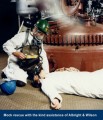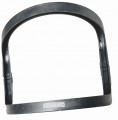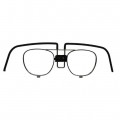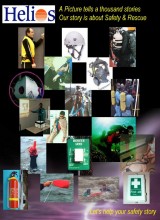 Loading... Please wait...
Loading... Please wait...Categories
 Recently added
Recently added
-
£1,500.00 (inc VAT) £1,250.00 (ex VAT)

-
£52.46 (inc VAT) £43.72 (ex VAT)

-
£57.12 (inc VAT) £47.60 (ex VAT)

-

-
£137.20 (inc VAT) £114.33 (ex VAT)

Our Newsletter
- Home
- Safety Guidance and information downloads
- Respirator and filter guide to European Standards
Product Description
A Summary of Test protocol and classification of Respirators.
(Abstracted information from the download)
|
EN Ref: |
Application Notes on Full face-mask filters, usually called 'canisters'. |
Chemical Family |
Type |
Colour |
Our SKU reference |
|
143 |
Three classes of efficiency are generally available but FFMs are usually fitted with P3 filters |
Particulate filters |
P2 |
White |
N/A |
|
142 |
Use P3 filters, for Solid, liquid, radioactive and toxic particles,bacteria and viruses, with full-face-masks and mostly so for half-masks. |
Particulate filters |
P3 |
White |
052670 |
|
141 |
Acid gases and vapours, e.g. sulphur dioxide, hydrogen fluoride,formic acid, nitric dioxide. |
Sulphurous gases |
E |
Yellow |
042972 |
|
141 |
Ammonia and organic ammonia derivatives. |
Ammonia |
K |
Green |
042873 |
|
141 |
Organic gases and vapours, that is: solvents with a boiling point above 65 oC. |
Organic |
B |
Brown |
042870 |
|
141 |
Inorganic gases and vapours, e.g. chlorine, hydrogen sulphide and hydrogen cyanide and mineral acid vapour. |
Inorganic Gases |
A |
Grey |
042871 |
|
371 |
Volatile organic solvents (VOCs) with boiling point below 65 oC.Carbon in these filters has a greater adsorption surface. |
VoCs |
AX |
Brown |
N/A |
|
141/143 |
Acid gases and vapours, (e.g. mineral acids and strong organic acids; sulphur dioxide, hydrogen fluoride, formic acid, nitric dioxides, solid and liquid radioactive and toxic particles, bacteria and viruses |
Sulphurous gases |
E |
Yellow/ \white |
043072 |
|
141/143 |
Ammonia and organic ammonia derivatives, solid and liquid radioactive and toxic particles, bacteria and viruses. |
Ammonia |
K |
Green |
042673 |
|
141/143 |
Organic gases and vapours, e.g. solvents with a boiling point above 65 oC, solid, liquid, radioactive and toxic particles, bacteria and viruses. |
Organic |
B |
Brown/ white |
042670 |
|
141/143 |
Inorganic gases and vapours, e.g. chlorine, hydrogen sulphide, hydrogen cyanide and solid, liquid, radioactive and toxic particles, bacteria and viruses. |
Inorganic Gases |
AP3 |
Grey/ white |
042671 |
|
371/143 |
Gases and vapours from organic compounds with boiling a point below 65 oC, solid, liquid, radioactive and toxic particles, bacteria and viruses |
VoCs |
AXP3 |
Brown/ white |
042770 |
|
141/143 |
Military and Civil Defence usage - similar to AXP3 but note that many CBW agents are less noxious than some industrial chemicals. |
Ionising particulate +B+P |
CBRN |
|
042798 |
Why so many Filter classes - especially for gases and vapours?
Firstly: particulate matter (including dust, liquid aerosol, smoke and fume) requires abstraction differently to gases. Filters for particulate are classed and described by the means needed to test them
Secondly: most respirator filters, designed to remove gases and vapours, comprise a filter bed of finely divided carbon, whose surface area is very large, in relation to the mass presented.
To do this, such carbon compounds are usually made from either the charcoal of ground coco-nut shells, whose hollow, fibrous structure presents a huge surface area, full of tiny chambers, or pores; or else, reconstituted carbon black, bound and made in to pellets, presenting an almost like surface area.
The latter tends to be denser and, having a greater weight per volume, will also tend to have higher 'saturation' levels of filtrate. Compared with coco-nut shell, its RATE of adsorption is lower, meaning that for similar effect, it requires a deeper filter bed, which implies higher breathing resistances; unless the filter diameter is also increased.
The characteristics of these two types, however, present fairly similar filtration patterns and, perhaps a more important issue is the way the carbon pieces are packed (as tightly as practicable, to reduce 'streaming' - that is, to prevent polluted airstream passing the filter medium, without proper adsorption.
This Wikipedia link provides further, useful reference, to understanding the mechanism of this sort of ‘filtration’: http://en.wikipedia.org/wiki/Activated_carbon
When adsorbed, reactive gases stay in close proximity to the Carbon, if they can. And they can do so, provided that the partial pressure of the gas in the carbon pores is not too high - higher than that in the passing air-stream, for instance. Thus the gases and vapours are adsorbed on to the carbon surfaces and held in its tiny pores. Should a clean air-stream pass through the filter bed, the adsorbed gases will leach back in to the air-stream because the intra-molecular London, or Van der Vaal's forces, which attract them together with the Carbon are not as strong as the forces of gaseous dispersion. These dispersive forces; one of which is Brownian movement - another of which might be the molecular energy give by a rise in temperature, will be increased by differences in gas partial pressures - including reductions in ambient air pressure. Gas viscosity represents a further variable that will influence adsorption and 'de-sorption'.
The tendency for adsorption to occur is increased when some metallic atoms, usually reactive with the contaminant are already present, in small amounts, in proximity with the Carbon pores. Thus the filters can be 'tuned' to faster adsorb certain groups of chemicals. This represents neither a catalytic or conversion reaction. It is, again, akin the intra-molecular forces that alter molecular behaviour, such as London forces - in effect, the opposite of gaseous dispersion forces we call Brownian movement.
Commonly, the compounds used to impregnate the Carbon; priming it to faster adsorb chemical families such as Halogens, Acid and Sulphurous gases, Ammonia and so forth; will be metallic Cations. Iron, Aluminium and Silver halides are such examples. Plain Carbon is often much better, however, at adsorbing most organic, generally less reactive gases - even acidic ones because organic acids are only weakly acidic.
Thus, because the science of abstraction is imperfect, there are a wide variety of filters made to best suit differing ranges of pollutants.
So, then: what happens is, say, one uses a plain carbon filter (type A) on Ammonia, instead of an Ammonia (type K) filter? The answer is: Not much. The Ammonia will not be attracted to the Carbon so quickly and the filtration will be less ideal. But it will still work. That, of course, is not a commendation to use incorrect filters. It is simply an observation.
Some respirator filters are advertised to filter out Carbon Monoxide. These must have special mention because the mechanism is not by adsorption but by chemical REACTION. Such filters fall outside the scope of the references above.
Alike all air gases, which cannot be filtered by carbon adsorption methods, is Carbon Monoxide (CO) - the product of incomplete, carbon combustion. To remove it from the respired air-stream requires that it is converted (reacted) in to something harmless. The best way to get rid of it is to change it to Carbon Dioxide - not ideal but non-toxic, in low concentration.
This is done, within the filter, by catalysis. Passing the CO past a mixture of Manganse Oxides (compounds that look similar to carbon black but which are much denser), in the presence of Oxygen (from the air) causes the CO to oxidise to Carbon Dioxide, thus preventing poisoning.
A problem with such filters (commercial types are made by MSA and Drager) is that the reaction is exothermic, often generating such heat as might cause the air breathed to assume an unhealthily high temperature, say exceeding 40 degrees C, where the CO concentration has been high. Such filters (media) are often present in 'Smoke hoods' and respirators designed for fire escape.
Dust Filters: Conventionally, respirator mask filters (replaceable ones) use either semi-dense, non-woven screed, or paper, to filter particulate matter. Some filters, particularly those designed to cope with heavy, hygroscopic matter, such as coal dust, use, instead, merino wool fibres, impregnated with a form of resin, to increase their inherent property of generating static electricity, as an air flow passes through the filter bed - more or less in the same plane as the fibre direction.
In this case, particles are slowed and attracted to the fibres, by static electricity - although there is a certain amount of mechanical filtration involved, too. The practical differences between these, two methods of filtering is that the wool filters offer less air resistance (breathing resistance) and therefore require lower breathing effort, relative to the size of the filter bed - and, consequently less leakage around the mask.
These, woollen filters also tend to clog less, able to carry a higher filtrate mass, before exceeding the pressure drop limits, across them; as they are used. Traditionally, filters made in Britain and the USA, used this method; each having a large coal-mining industry.
Filters made from resin impregnated, merino wool (merino because of its long staple and resin to improve the static attraction of particles) do not work well in damp atmospheres - significant wetness reducing the particular attraction to the fibre. Most dust filters, these days are of the mechanical type and the design of these has improved, over the years, so that the pressure drop over the filter is reduced - as is clogging.
The mechanical filters: originally favoured more on the Continent of Europe, where Quartz dust and other similar particulate was considered important: tend to clog quite easily and the filtering screed, from which they are made, requires special folding - much as is used in making vehicle air filters - to increase the filtering area as far as possible.
Sometimes, the filter papers are made from cellulose fibre, some times, glass fibre and these days, very often, from long chain polymers. These, latter materials are most commonly used in Filtering Face-pieces, which by numbers, represent the greatest use of RPD.
Toxic particles (dusts and inert aerosol) are defined as: Having a diameter (Stokes) of between 0.3 Microns and 10 Microns. A Micron is a millionth of a Metre. The average, human hair has a diameter between 25 and 35 Microns. A Fibre is defined as a particle whose length is three or more times its mean, Stokes diameter. )
Gases and vapours are defined: Gases and vapours - a vapour is a gas on the point of condensation - cannot be removed other than by reacting them in to innocuous substances or by adsorbing them on to the surface of a filter bed which is inert to them.
Flash point: Gases (as vapours) leave the surface of a liquid when enough energy (usually heat) is given to it surface molecules, that they overcome the intra-molecular attraction, we call Surface tension. Gases (as vapours) condense in to the liquid surface, conversely, when energy is lost. The point (liquid temperature) at which the same number of molecules evaporate as does condense, is called the FLASH-POINT of the liquid. It is a useful number because it tells us much about the chemical nature of the liquid - especially if we also know its boiling point. It is useful in managing safety because, if the ambient, working temperature is above the flash point, we known that a significant volume of the chemical will be present in the atmosphere.
Boiling point: Gases and vapours evolve from liquid surfaces as described above. The boiling point is the temperature at which ALL the liquid will change phase, to gas, if it is not contained by an increase in pressure - to 'hold-in' its molecules, together. Typically, the higher the surface tension a liquid displays, the higher will be the heat energy required for it to reach its boiling point. This does not have anything directly to do with its boiling temperature. Water, for example (at STP), boils at 100 degrees, whereas; cooking oil boils at about 180 degrees. Yet a scald from boiling oil is likely to be far less serious than one from boiling water! To find out why, you will have to read the detailed safety notes, from several of our courses that explain latent heat.
Vapour density: Gases and vapours have differing densities depending on their component molecular weights and densities. When calculating for safe methods of work, we relate these to air-density, where air is given a density of ONE. Scientifically, vapour density refers to the partial pressure contributed to the topical atmospheric pressure by the vapour in question. These are two, quite different things and must not be confused. The one determines whether the gas, or vapour is lighter than air - and, thus, whether it will rise or fall, so that we can predict risk. The other is used to determine the likely, mean concentration of pollutant in the atmosphere.
Lower and Upper Explosive Limits: Gases and vapours that are flammable in air require a range of dilution, in order to burn. This is calculable, from their chemical formulae - certainly so far as the 'ideal' mixture is concerned. When there is too little fuel gas to ignite, the gas mixture is said to be below its lower explosive limit. When, conversely, there is too much fuel gas and the mixture too 'rich' to allow effective combustion, we say it is above its upper explosive limit. We do not necessarily mean Explosive, at all. We mean that it will burn in air, within the range of its LEL and UEL. An explosion is technically defined as an ignition where the flame front travels at more than thirty Metres per second.
Auto-ignition temperature: Gases that are flammable will ignite at differing temperatures. Each has a particular temperature when it will ignite, in air, at one atmosphere: the conditions that define the substance's auto-ignition temperature.
It is difficult to avoid ‘trade-jargon’ in describing a synopsis of what you should know, to select the right kind of mask and filter but, to help, here is a mini-key to some relevant expressions:-
Protection Factor: This represents the fractional denominator by which the incident challenge concentration was divided, when tested. It is a fraction that expresses the incident contamination divided by the total inward leakage.
For example, if the incident atmospheric challenge comprised 500 milligrammes/M3 of special test dust, or ‘particulate’ and the filtered air (from the inside of the mask) contained 50 milligrammes/M3, then the Protection Factor (PF) was 10.
This, then, is sometimes referred to as the Nominal Protection Factor because it may not be considered necessarily representative of the TOTAL INWARD LEAKAGE (the amount that managed to get past the mask) experienced by all wearers, in all circumstance.
Effective Protection Factor: The ‘EFP’ attempts to describe the protection actually attained, taking in to account, mask leakage, through face-fit aberrations and brief intervals when the mask was not used and the user exposed to the unmitigated challenge.
Assigned/Assumed Protection Factor: This estimates the effect of problems relating to imperfect face-fit and has been based on ‘industry’ experimentation and other research to divine practice from theory, in providing protection that is reliably calculable of its effectiveness.
Fit-Factor: The Fit Factor relates to measurement of the leakage around a specific wearer and suggests the suitability of the face-piece for his protection – within the design limits of that, specific type of mask and filter, etc. (all RPD)
RPE/RPD: Respiratory Protective Equipment, or Respiratory Protective Device. In other words, the general term for respirators, masks, hoods and breathing apparatus.
RPD is divided in to two basic types: that which filters, or purifies incident air-streams and that which provides its own air supply, such as breathing apparatus, incorporating air cylinders, or an air supply line. Each type, in turn, is classified according to the robustness and environment of its intended use and, often but not ideally, by its means of design.
Filters (filtering respirators) are classified in to those designed for particulate matter, such as smoke, fume and dust and those designed to combat sir-streams polluted with vapours and gases. Each is then sub-divided according to the efficiency with which it filters the intended pollution (known as the challenge, when specified by concentration). These divisions are usually reflected by specific test protocol, intended to determine the efficiency of each type. The divisions are made necessary owing to the technical limitations of differing filtering techniques.
Currently applied Test Protocol (for Masks and Filter devices) are described below and, on the last page, is a table describing the types of filter most usually available. The sale and use of this equipment, in the EU, is governed under the European Directive 686 (etc): Personal Protective Equipment.
If it all seems an overly complex system, I suggest it is. Prior to our membership of the EU, Britain, Scandinavia and Germany all had perfectly good, workable systems of test protocol and each had relatively few confusions, resulting accident or difficulties. The desire for a set of harmonised standards and test protocol was very valid and laudable but I regret some of that exciting vision we shared, back in 1974, has been lost in the muddy waters of vested interests and irrelevances, during the past thirty-five years.
Bill Parker,
Technical Director.
Find Similar Products by Category
Customers Who Viewed This Product Also Viewed
-
£0.00 (inc VAT) £0.00 (ex VAT)

-
£7.14 (inc VAT) £5.95 (ex VAT)

-
£3.60 (inc VAT) £3.00 (ex VAT)

-
£0.00 (inc VAT) £0.00 (ex VAT)















